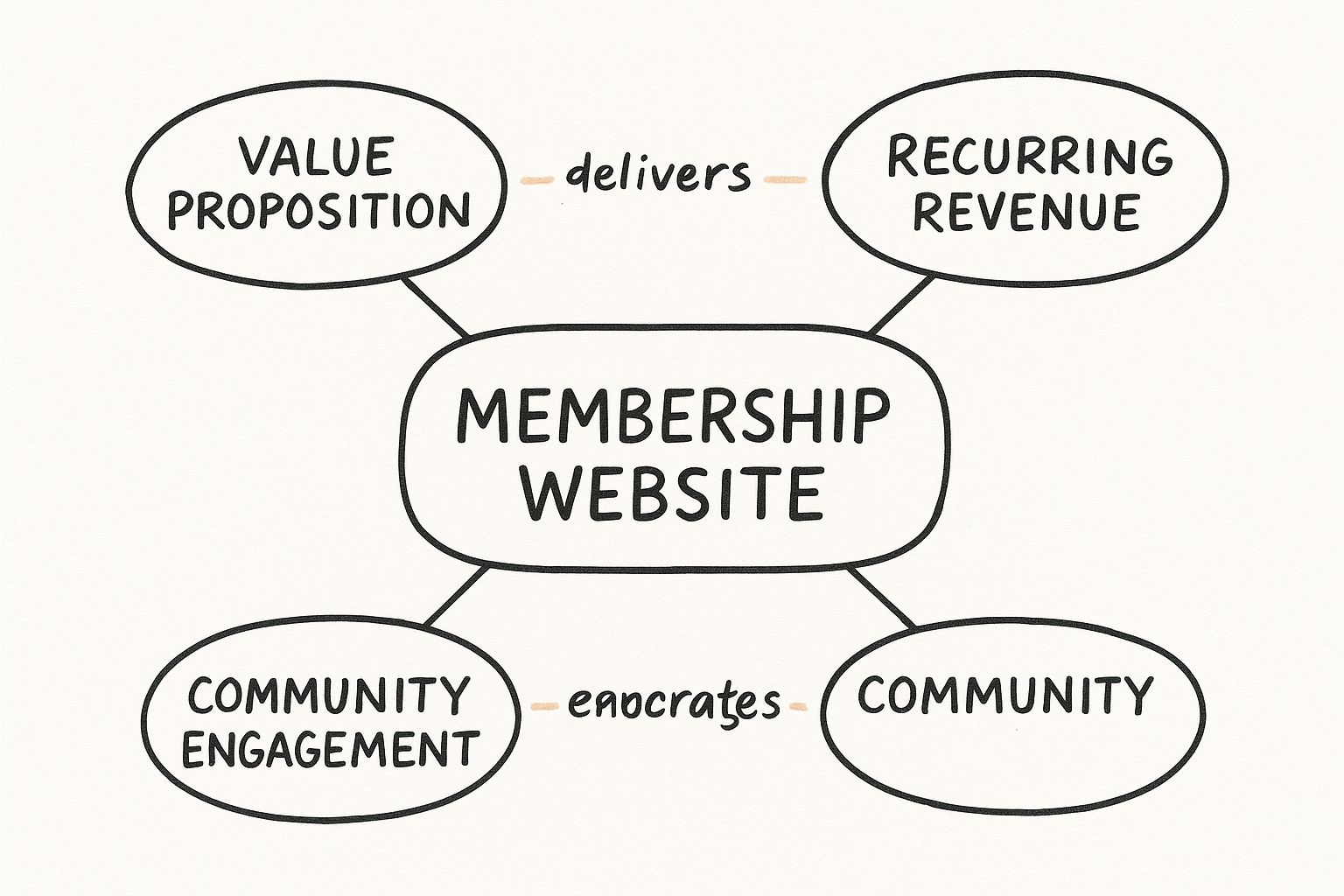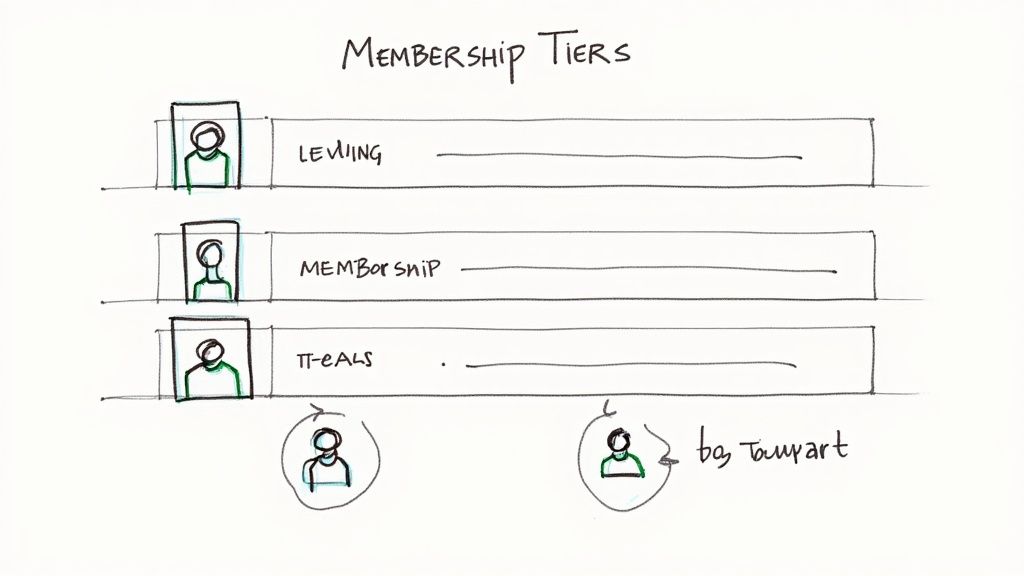July 29, 2025

So, you’re thinking about starting a membership website. The basic idea is simple enough: you choose a niche, pick your tech—whether that’s a WordPress setup or an all-in-one platform—and then start creating exclusive content behind a paywall. You're essentially building a gated community where members pay for ongoing access to valuable resources and connections.
But let's pause before we get lost in the technical weeds.
Understanding why this model is so effective is the real first step. A membership site completely changes the game by moving you away from the constant grind of one-off sales. Instead of always hunting for the next customer, you start building a foundation of predictable, recurring revenue.
That stability is a game-changer. It gets you off the feast-or-famine rollercoaster that plagues so many entrepreneurs and creators. Even better, it gives you the confidence and the cash flow to invest back into your community, creating even better content and a richer experience for your members, all because you have a reliable income stream.
Beyond the financials, this is where the magic really happens. A membership site is one of the best ways to build a direct, powerful relationship with your audience. You're not just selling a product; you're creating an exclusive hub where people with shared passions can connect, learn, and grow together.
This community quickly becomes your biggest asset. It’s a living, breathing part of your business that provides:
A successful membership isn't just a content library; it's a destination. It’s a place where members feel they belong, making the recurring fee an easy decision because the value extends far beyond the content itself.
This concept map really brings it all together, showing how the core pillars of a great membership site all support one another.

As you can see, your value proposition, the recurring revenue, and community engagement aren't separate things—they’re all interconnected, holding up the entire structure.
To truly grasp the shift, it helps to see the two models side-by-side. The traditional approach has its place, but the membership model offers a fundamentally different—and often more sustainable—way to build a business.
While a one-time sale gives you a quick cash injection, the membership model provides the foundation for long-term growth and deeper customer relationships.
This isn't just a niche trend; it’s a massive economic shift. The subscription economy is absolutely booming. Projections show that by 2025, it will account for nearly 53% of all software-generated revenue worldwide.
And it's not just software. Look at online learning—there are over 3.2 million students enrolled in online courses, a clear signal that people are hungry for membership-based education. These numbers prove one thing: consumers are not only comfortable with subscriptions, they’re actively seeking them out. If you want to dive deeper, you can read more about membership site statistics and trends that highlight this growing demand.
Before you even dream about picking a website theme or setting up payments, let's talk about what really makes a membership site successful. It's not the fancy software. It's the foundation you build long before you write a single line of code.
You need to get laser-focused on two things: the specific problem you solve and the exact person you're solving it for. Getting this right from the start is what separates communities that thrive from those that fizzle out after a few months.
So many people jump into building something they personally think is cool. The real magic happens when you uncover a genuine, nagging problem your audience is desperate to solve. What's that one thing that keeps them up at night? What's the roadblock they just can't seem to get past on their own?
Your membership needs to be the most direct, obvious solution to that pain.
Once you’ve nailed down that core problem, you can build your unique value proposition. This isn't just a boring list of features. It's the promise you make to your members. It clearly answers their biggest question: "Why on earth should I give you my credit card number every single month for this?"
Maybe your value comes from:
Let’s say you’re a seasoned freelance graphic designer. You constantly see beginners struggling to price their work and land their first few clients. Your membership could offer a vault of battle-tested proposal templates, host monthly "client-getting" masterclasses, and provide a private forum where members get feedback from you and their peers. See? The value is the entire support system, not just one piece of it.
A powerful value proposition shifts the entire conversation. It moves a potential member from thinking, "How much does this cost?" to "How fast can I get in?" That mental shift is everything when it comes to keeping members around for the long haul.
Okay, you know your value. Now, how do you package it? You don't have to give everyone the keys to the entire kingdom. Creating different membership tiers is a smart way to meet people where they are, both in their journey and their budget. This is a crucial step if you want to create a membership website that actually brings in predictable, steady income.
Think about a simple tiered model. Something like this:
This kind of structure gives people an easy "yes" to get started and a clear path to upgrade when they’re ready for more. When it comes to pricing, don't just guess. Your price should feel like a no-brainer compared to the value and transformation you deliver. Tie your pricing directly to the results you help people achieve.
Putting in this strategic work upfront ensures you're not just building a website, but a sustainable business that attracts the right people and keeps them coming back.
 The technology that powers your membership site can either be your biggest asset or your worst nightmare. Honestly, getting this part right isn't about chasing the “best” platform out there. It’s about finding the right fit for you—your vision, your budget, and how comfortable you are with the technical side of things.
The technology that powers your membership site can either be your biggest asset or your worst nightmare. Honestly, getting this part right isn't about chasing the “best” platform out there. It’s about finding the right fit for you—your vision, your budget, and how comfortable you are with the technical side of things.
This decision is often what separates a smooth launch from a frustrating, headache-filled one. You're essentially choosing between two main roads: building on a self-hosted platform like WordPress or using a dedicated, all-in-one service. Let's break down what that really means.
With a self-hosted solution, you're in the driver's seat. The most common setup is a WordPress site paired with a powerful membership plugin. This path gives you complete control and flexibility. You own all your data, and you can customize every single detail of the experience.
All-in-one platforms like Kajabi or Teachable are built for simplicity. They take care of all the technical heavy lifting—from hosting and security to updates and integrations. This frees you up to focus on what you do best: creating amazing content and engaging with your community. That convenience usually comes with a higher monthly price tag and less creative control over the design.
The right platform should feel like a natural extension of your brand, not a daily puzzle. Think about where you want to go long-term. If you envision a complex, feature-rich site down the road, the endless possibilities of WordPress are hard to beat. If getting to market quickly and easily is your top priority, an all-in-one system is probably your best bet.
For a much deeper look at the pros and cons, check out our guide on choosing your membership site platform. It breaks everything down so you can make a choice you feel confident about.
No matter which platform you choose as your foundation, you'll need a few other tools to make everything run smoothly. These are the gears that work behind the scenes to automate your business and deliver a professional experience.
First, a reliable payment gateway is non-negotiable. Stripe and PayPal are the undisputed industry standards. They’re trusted, secure, and integrate with just about any membership software you can find, making it easy to handle recurring subscription payments.
Next up is your email marketing service. This is your direct line to your members. You'll use it for everything from welcome sequences to new content announcements. Tools like Mailchimp or ConvertKit are critical for building relationships and keeping members from leaving.
Finally, you need a place for your community to connect. While some platforms have basic, built-in forums, a dedicated community hub like GroupOS can create a truly vibrant, interactive space. After all, connection is often the main reason people stick around.
Investing in the right tech isn't just a "nice-to-have." In fact, about 70% of organizations are planning to invest in technology to improve their websites, because they know it's crucial for both attracting and retaining members. You can discover more insights from the 2025 Membership Performance Benchmark Report to see where the industry is heading.

Let's be honest: the exclusive content you provide is the absolute soul of your membership. If it just feels like a random jumble of PDFs or a few blog posts hidden behind a paywall, you'll see people leaving as fast as they joined. Your real goal is to design an experience that feels completely essential—something your members can't imagine their lives or careers without.
This means you need to think beyond just static files and start creating dynamic, valuable experiences. What do your people actually want? For instance, a community for new photographers might get far more out of a monthly live Q&A with a seasoned pro than another downloadable checklist. The secret is offering something that solves a real problem and can't be found with a quick Google search.
To keep your members hooked for the long run, your content needs to have both variety and substance. This simple truth helps you cater to different learning styles and keeps things exciting month after month, preventing that dreaded "content fatigue."
Here are a few powerful formats I've seen work time and time again:
Of course, a huge part of the content experience is the community itself. For a deep dive, check out our guide on https://groupos.com/blog/how-to-grow-an-online-community and make it the most valuable asset you offer.
How you deliver your content is just as crucial as the content itself. I've seen countless creators make the mistake of dumping their entire content library on a new member on day one. It's a recipe for overwhelm. This "analysis paralysis" is real—when faced with too much, people often do nothing at all.
A "drip-feed" content strategy is one of the most powerful tools for fighting overwhelm and boosting long-term retention. By releasing content on a predictable schedule—say, weekly or monthly—you create a rhythm and give members something to anticipate.
This approach stops your membership from feeling like a one-off purchase. Every new piece of content that drops is a fresh reminder of the ongoing value they're paying for.
You can easily plan this with a content roadmap. Just map out what you plan to release over the next 3 to 6 months. This not only keeps you organized but also gives you exciting things to announce to your community, building hype and making the idea of canceling seem unthinkable.
Building a fantastic membership site is just the first part of the equation. If you don't have a solid plan to launch it, all that great content might never find an audience. The real goal isn't just to flick the "on" switch; it's to create a groundswell of excitement that leads to a strong, profitable start. That means your marketing has to kick in long before you're ready to take anyone's money.
The secret is building anticipation. I always recommend starting with a dedicated pre-launch email waitlist. Think of this as your founding community—a group of people who are already interested in what you have to offer. Give them a great reason to sign up, like a special "founding member" price, early bird access, or even a free guide that gives them a taste of the value you'll be providing inside the membership. This gets you a warm audience that’s genuinely excited for launch day.
How you actually open your doors makes a huge difference. There's no single best way to do it; the right model really depends on your business and your audience.
Your launch is so much more than a transaction; it's a statement. It signals to your audience that you’ve built something valuable and exclusive—something worth their immediate attention. A great launch sets the entire tone for your community's future.
During your launch, your sales page is your most critical piece of marketing. This is where you have to clearly and persuasively sell the value of joining. Don't just list a bunch of features—sell the transformation your members will experience.
Your page needs compelling headlines, social proof like testimonials (if you have any from a beta group), and crystal-clear calls-to-action. Break down exactly what people get, who the membership is designed for, and the specific problems it solves for them. Use great visuals and be upfront about the price. Your job is to answer every single question a potential member might have, removing any hesitation that could stop them from clicking that "Join Now" button.
The potential here is enormous. The subscription e-commerce market is expected to explode from $199.41 billion in 2023 to a staggering $2,227.63 billion by 2028. This shows a massive global appetite for memberships. To get your piece of the pie, focus on building an engaged micro-community with tools like forums and live chat, and make sure your site works beautifully on mobile. If you want to dive deeper, you can discover more insights about membership site trends on MemberPress to keep your strategy fresh.

Even with the best-laid plans, you're bound to have questions when diving into something new. It's totally normal. Here are some of the most common ones we hear from people just starting their journey to create a membership website.
The cost really depends on the tools you choose. Your budget can swing quite a bit based on your technical setup.
If you go the WordPress route, a premium membership plugin alone will likely run you $150 to $400 per year. And that's before you even factor in your annual web hosting fees.
All-in-one platforms, on the other hand, bundle everything you need for a single monthly price, usually between $100 to $400 a month. No matter which path you take, don't forget to budget for payment processing fees (typically a small slice of each sale) and your email marketing service.
No, you absolutely do not. This is probably the single biggest myth that stops talented people from ever getting started. I've seen firsthand that a small, hyper-engaged group of a few hundred people can be way more valuable than a huge, disengaged list.
What truly matters is the strength of the connection you have with your audience, not the raw numbers. A fantastic way to kick things off is by launching a "founding members" program to your most loyal followers. It's the perfect strategy to validate your idea and build powerful momentum from day one.
The real objective is to keep your members so engaged and invested that their subscription becomes a non-negotiable part of their life. A strong community and undeniable value are your best defense against cancellations.
Your content's main job is to solve a real, recurring problem for your members. It has to be something they can't just find for free with a quick Google search. Think exclusive, actionable, and genuinely helpful.
Some of the most successful content formats we see are:
Keeping members happy—and subscribed—boils down to two things: delivering consistent value and building a real sense of community. You have to keep adding fresh, high-quality content and be an active, visible presence in your own community. It shows you care.
But it goes beyond just content. Make your members feel heard by actually listening to their feedback. Things like surprise bonuses, member-only virtual meetups, and celebrating their wins can make a huge difference in reinforcing the value of their subscription. For a much deeper dive, take a look at our guide on essential membership retention strategies to help your community thrive for the long haul.
Ready to build a thriving, engaged community without all the technical headaches? GroupOS gives you an all-in-one platform to manage your members, content, and events with ease. Start your free trial today and see just how simple it can be to bring your membership vision to life.


